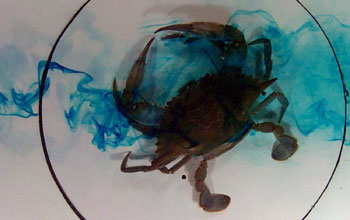Multimedia Gallery
Blue crab in turbulent odor plume visualized with red dye
A blue crab in a turbulent odor plume visualized with red dye.
More about this Image
A combined analysis of hydrodynamic forces, odor signals structure, and behavior indicates that body orientation in blue crabs is sensitive to both drag costs and the odor plume structure.
Blue crabs assume specific body angles during movement that depend on both flow and odor conditions, and which have consequences for the structure of odor signals arriving at their chemosensory appendages as well as those structures transmitted downstream.
These interactions between body orientation, drag force, and plume structure have a variety of implications for foraging energetics and navigational strategies. Blue crabs appear to perform a cost-benefit analysis in deciding how to position their bodies in response to food odors. Rather than adopting a fixed orientation that minimizes the drag, blue crabs in slow flows position their body to increase their ability to acquire chemical signals when odor is present, even though this increases both drag and the cost of locomotion. Crabs assume a drag-minimizing posture under odorless conditions or when odor is present in more rapid flows. This, along with similar experiments, indicates that the flow environment influences animal behavior by affecting both the cost of locomotion and the ability to acquire information from chemical plumes.
Marc Weissburg, an animal behavior biologist and assistant professor, and Don Webster, a civil and environmental engineering assistant professor--both from the Georgia Institute of Technology, conduct experiments on chemical odors in water and the behavioral response of blue crabs and other marine animals to these chemical signals.
Weissburg wants to understand the chemical signals that aquatic animals, such as blue crabs and snails, use to track food and mates from a distance, generally a few meters. He is working in collaboration with Webster, an expert in fluid mechanics. Webster uses a 24-meter, 1,400-gallon flume--essentially an artificial river--to conduct experiments on the turbulent transport of chemical odors through water. Specifically, he investigates the physical mixing mechanisms of the turbulent flow, and quantifies the distribution of the odor filaments. Meanwhile, Weissburg collects information on how animals respond to the chemical signal through behavioral experiments in a smaller flume. They integrate their data to get the big picture.
This research is supported by the Office of Naval Research and the National Science Foundation (Sensory Systems Program, grant IOS 0321444). (Date of Image: 2003)
Credit: Dr. Donald R. Webster and Dr. Marc Weissburg, Georgia Institute of Technology
Images and other media in the National Science Foundation Multimedia Gallery are available for use in print and electronic material by NSF employees, members of the media, university staff, teachers and the general public. All media in the gallery are intended for personal, educational and nonprofit/non-commercial use only.
Images credited to the National Science Foundation, a federal agency, are in the public domain. The images were created by employees of the United States Government as part of their official duties or prepared by contractors as "works for hire" for NSF. You may freely use NSF-credited images and, at your discretion, credit NSF with a "Courtesy: National Science Foundation" notation.
Additional information about general usage can be found in Conditions.
Also Available:
Download the high-resolution JPG version of the image. (878.7 KB)
Use your mouse to right-click (Mac users may need to Ctrl-click) the link above and choose the option that will save the file or target to your computer.



 All images in this series
All images in this series